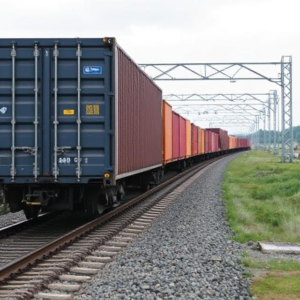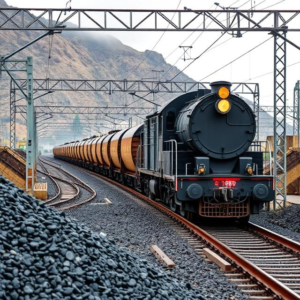Railway Cargo and Containerization Explained
Let’s break it down in a simple way so you can understand how railway cargo works and what containerization is!
1. What is Railway Cargo?
Railway cargo refers to goods (or items) that are transported by trains instead of trucks or ships. It’s one of the most efficient ways to move large amounts of things over long distances. Instead of just transporting people, trains also carry cargo like:
- Food and beverages
- Electronics
- Clothing and textiles
- Industrial materials (like steel or cement)
- Consumer goods (like furniture, toys, and appliances)
Trains can carry tons of cargo at once, making them ideal for moving large quantities of goods across the country or even between countries.

2. What is Containerization?
Containerization is a system used to transport cargo in large, standardized containers that are easy to load, unload, and transfer between different types of transportation. Imagine a huge metal box that can be loaded onto a train, truck, or ship. These containers come in standard sizes (like 20 feet long or 40 feet long), which makes it easier to move goods because the same container can be used across different transport methods.
Why is Containerization Important?
- Efficiency: Loading and unloading goods is faster and more efficient when using containers because everything fits into a uniform size and can be quickly moved from one vehicle to another.
- Security: Containers keep goods safe from theft, damage, and bad weather.
- Cost-Effective: Since containers are standardized, it’s cheaper to move them, and it also saves time because loading and unloading processes are streamlined.
3. How Does Railway Cargo and Containerization Work Together?
When we talk about railway cargo with containerization, we mean that cargo is packed into these standardized containers, which are then loaded onto trains for transport. Here’s how it works:
Step-by-Step Process:
- Packing the Cargo: First, goods are packed into containers at a warehouse or shipping facility. These containers can carry various types of cargo, from electronics to food products.
- Loading onto Trains: After packing, the containers are transported to rail yards (places where trains are parked and loaded) and then placed onto freight cars. Trains are specifically designed to carry large containers, often called “container flatcars.”
- Transporting by Rail: The train then travels long distances to deliver the goods. Railways are a great way to carry large loads over land because trains can carry a lot of cargo at once, and they can travel across countries or continents.
- Unloading at the Destination: When the train reaches its destination (a port, warehouse, or another rail yard), the containers are unloaded. Sometimes, they are transferred directly onto trucks for final delivery, or they may be unloaded to ships for international shipping.
- Transfer Between Transport Modes: One of the best things about containerization is that containers can be easily moved between different types of transportation. For example:
- From ship to train: If a container comes from overseas on a ship, it can be transferred onto a train and moved inland.
- From train to truck: After the train reaches the destination rail yard, the container can be placed onto a truck to be delivered to a local store or business.
4. Why Use Trains for Containerized Cargo?
There are several reasons why trains are a great choice for transporting containerized cargo:
- Large Volume: Trains can carry hundreds of containers at once, much more than a single truck or ship. This helps move goods in bulk efficiently.
- Cost Efficiency: Rail transport is often cheaper for long-distance shipments compared to trucks, especially when moving large quantities of cargo.
- Environmentally Friendly: Trains are more fuel-efficient than trucks, which means they can reduce carbon emissions and are better for the environment.
- Reliability: Trains follow fixed tracks, meaning they don’t get stuck in traffic or face unpredictable road conditions like trucks do.
5. Types of Cargo Transported by Rail and Containers
There are many different types of goods that can be moved by railway and containerization:
- Consumer Goods: Electronics, furniture, clothing, and toys.
- Raw Materials: Steel, coal, minerals, and timber.
- Food Products: Fresh produce, packaged food, and beverages.
- Automobiles: Cars and vehicles are often transported in large containers by train.
6. Advantages of Railway Cargo with Containerization
- Efficiency: It speeds up transportation and reduces costs by allowing easy transfers between ships, trains, and trucks.
- Safety: Cargo is kept secure inside containers, making it less likely to get damaged or stolen.
- Global Trade: Containerized rail transport is a key part of global trade, allowing goods to move between countries quickly and cheaply.
- Reduced Road Traffic: Since goods are moved by train, there is less reliance on trucks, which helps reduce traffic congestion and road wear.
7. Challenges of Railway Cargo and Containerization
- Infrastructure Costs: Building and maintaining the infrastructure, like rail tracks and stations, can be expensive.
- Limited Access: Not all areas are connected by rail, so trains may not be able to reach some remote regions.
- Delays: Weather, track maintenance, and other factors can cause delays in the movement of cargo by train.
Conclusion
Railway cargo with containerization makes transporting goods over long distances much easier and more efficient. By using standardized containers that can be transferred between trains, trucks, and ships, goods can be moved quickly, securely, and cost-effectively. This system has become a key part of global trade and plays an important role in ensuring that products get from manufacturers to stores or consumers around the world.
Keywords: Indian Railway, Railway











